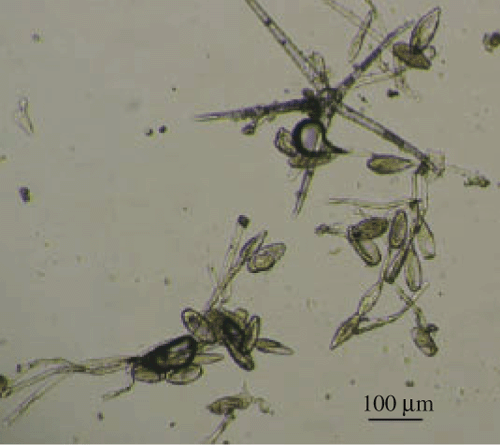Powdery mildew caused by Leveillula taurica on Alcea rosea in Turkey
H. Kavak A B and M. Dikilitas AA Plant Protection Department, Agricultural Faculty, University of Harran, Sanlıurfa 63040, Turkey.
B Corresponding author. Email: hkavak@harran.edu.tr
Australasian Plant Disease Notes 1(1) 7-8 https://doi.org/10.1071/DN06004
Accepted: 27 June 2006 Published: 24 August 2006
Abstract
An outbreak of powdery mildew caused by Leveillula taurica was observed on a new host, Alcea rosea, in Turkey in 2004 and 2005. Infection continued throughout the summer period and reached its peak level in October. The teleomorph of the pathogen was produced in early autumn.
During surveys conducted on hollyhock (Alcea rosea) in 2004 and 2005, severe symptoms of powdery mildew were observed on many plants, beginning in early summer and continuing through to mid-autumn in Şanlıurfa, in the south-eastern Anatolia district of Turkey. The symptoms, first observed in June, were chlorotic lesions, 8–13 mm in diameter, circular to irregular in outline on the upper leaf surfaces of the plants. The conidiophores and conidia of the pathogen were observed on the lower leaf surface under the microscope. Infection continued throughout the summer season with conidia only being observed. In October 2004 and 2005, ~50 and 80% of the plants, respectively, were found to be infected with the pathogen and exhibited varying levels of disease severity. Many lower leaves and some upper leaves were also covered completely with thick layers of persistent mycelium on both leaf surfaces (Fig. 1). On petioles and pedicels, some colony development was also observed. Early senescence and deaths was prevalent on severely infected leaves. Young seedlings, especially throughout the final period of the summer, were found to be very susceptible to the disease.

|
Appressoria developed on mycelia within the leaf tissue. The conidiophores emerged from stomata, singly or branched in groups of two to five, and formed dimorphic conidia in chains. The primary conidia were lanceolate (15–19 × 54–78 µm) and the secondary conidia were cylindrical (14–18 × 51–75 µm) (Fig. 2). The teleomorph of the fungus was generally produced in late August in both years with profuse numbers of cleistothecia being produced amid the mycelium, yellow at first and becoming dark brown or black at maturity. They were mostly round or broadly ovate and 95–220 µm in diameter. They contained up to 30 broadly oval or ellipsoidal asci (27–50 × 55–107 µm) each containing two ascospores (17–25 × 27–50 µm). Appendages of the cleistothecia were colourless and mycelial, irregularly branched and measured 30–110 µm in length. The identification of Leveillula taurica (Lev.) Arn. was based on the published description of the morphology of both anamorph and teleomorph given by Braun (1987).

|
Freshly harvested conidia of L. taurica were used to prepare a spore suspension, which was adjusted to 104 spores/mL. The spore suspension was sprayed onto 40-day-old seedlings of hollyhock, which were then placed in a moist chamber maintained at 55–80% relative humidity for 48 h at 27°C. After this period, the chamber was removed and the plants were allowed to dry before moving them into a glasshouse. Similar treatments were also performed on control plants, which were sprayed with sterile water only. Both the control and infected plants were incubated in different sections of the glasshouse to prevent cross-infection. Symptoms were observed within 2 weeks on the inoculated plants and were similar to those observed in the field. The control plants remained free of infection.
A. rosea is a common ornamental plant grown at home and private gardens and also in park areas in Turkey. It is grown as a decorative plant in many countries and is used for the treatment of influenza, ear, nose and throat infections. Recently, L. taurica has been recorded in Turkey on caper, Capparis spinosa (Kavak 2004). To our knowledge, A. rosea is a new host for L. taurica in Turkey.
Braun U
(1987) A monograph of the Erysiphales (powdery mildews). Beiheft zur Nova Hedwigia 89, 1–700.

Kavak H
(2004) Epidemic outbreaks of powdery mildew caused by Leveillula taurica on Capparis spinosa in Turkey. Plant Pathology 53, 809.
| Crossref | GoogleScholarGoogle Scholar |



